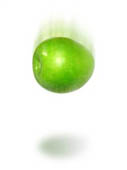
Purpose
To demonstrate Galileo's falling objects experiment that states "What goes up, must come down". After this experiment you'll be able answer the question "Do larger objects fall faster than lighter ones under the same conditions?"
Additional information
Born in 1564, Galileo Galilei was an Italian physicist, astronomer, philosopher, and mathematician. Around the year 1589 Galileo set out to prove that two objects of varying size and weight would hit the ground at the same time when dropped from great heights. This was contrary to popular belief and the teachings of Aristotle, who theorized that objects of greater weight fall faster than those of lighter weight. To prove his theory, it's said that Gelileo dropped a 10 pound ball and a 1 pound ball from the top of the Leaning Tower of Pisa. A large crowd witnesses Galileo prove his theory and disprove Aristotle’s when the balls hit the ground at the same time.
Sponsored Links
Required materials
- two balls of the same size, but different weights (preferably steel balls or balls not made out of rubber)
- a ladder (or an area of significant height where the balls can be dropped safely)
- a notepad to record observations.
- a video camera to record results (optional, but recommended)
- a video camera tripod (optional)
Estimated Experiment Time
About 10 minutes for multiple samplings
Step-By-Step Procedure
- 1. If using a video camera, set the camera up on a tripod or solid surface. Make sure to position the camera so that it can capture the entire procedure (from the point the balls drop to where they hit the ground).
- 2. Climb the ladder and prepare to drop both balls at the same time. It's best to have someone spot you and help you balance while on the ladder.
- 3. Once situated safely on the ladder, place a ball in each hand. Hold both hands out at equal length and distance.
- 4. Count to 3 and release the balls at the same exact time.
- 5. After the balls hit the ground, record the results in your notepad.
- 6. To verify your notes, review the optional video recording.
- 7. Repeat the experiment several times, preferably a minimum of 10 times. Record the results separately for each iteration of the experiment.
Note
To avoid injury, ensure everyone is clear from the area where you'll be dropping the objects, especially heavy objects. Also ensure that you have someone to help keep your balance if conducting the experiment from the top of a ladder.
Observation
When you dropped the balls from the ladder, which ball hit the ground first... the heavy ball or the light ball? If one hit before the other, how many times did this occur? Galileo's experiment is contingent on objects being dropped under the same conditions. With any experiment, there is a degree of human error that can result in skewed results. We conduct the experiment several times to ensure our results are accurate and to take into account variances (such as not releasing the balls at identical times). The video recording is key to ensure our testing conditions were identical and to verify results.
Result
When dropped, both the heavier ball and the lighter ball should hit the ground at the same exact time, proving Galileo’s theory that objects, in direct proportion to weight, fall at the same rate.
Sponsored Links
Take a moment to visit our table of Periodic Elements page where you can get an in-depth view of all the elements,
complete with the industry first side-by-side element comparisons!